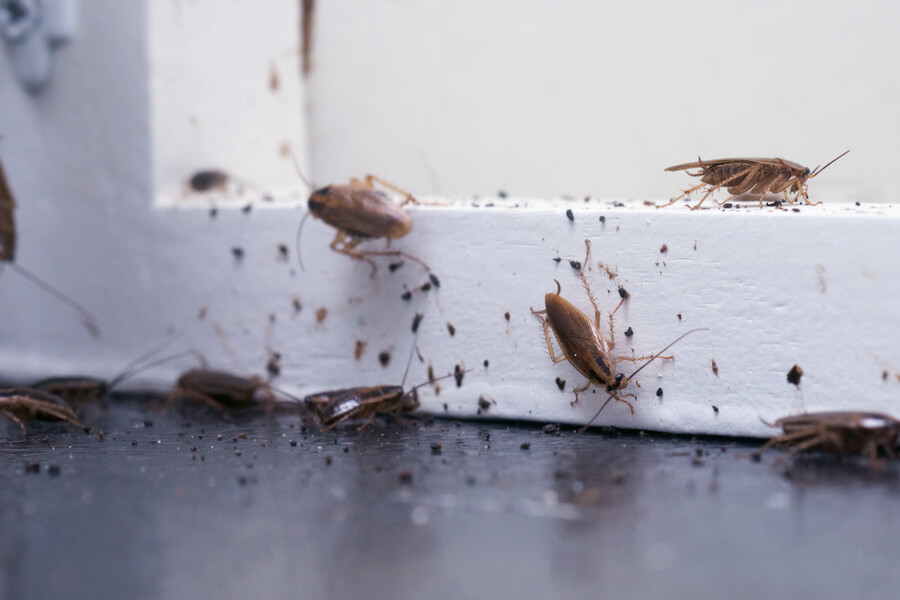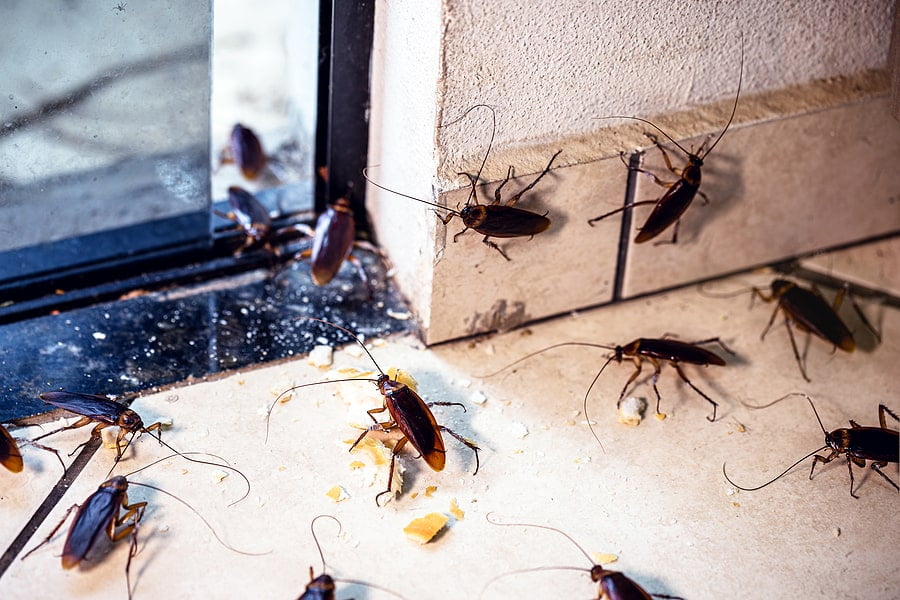Cockroaches typically seek shelter indoors during winter, invading homes and buildings to escape the cold. They hide in warm, secluded areas like basements, wall cavities, and around pipes and stoves.
As temperatures drop, cockroaches’ survival instincts kick in, prompting them to find refuge from the harsh winter conditions. These adaptable pests gravitate towards environments that can sustain their need for warmth and food, making human dwellings perfect winter retreats. Your home provides an ideal sanctuary with its ample food scraps, moisture, and heat, encouraging cockroaches to settle in.
Understanding their behavior during colder months is crucial for homeowners, as it can help in preventing an infestation. Simple steps, such as sealing entry points and maintaining a clean kitchen, can discourage these unwelcome guests. Keep an eye out for signs of cockroach activity, such as droppings or egg cases, to address any issues promptly and keep your home cockroach-free throughout winter.
Cockroach Winter Behavior
Cockroaches are known for their resilience, yet winter poses a unique challenge for these hardy insects.
Survival Tactics
In colder months, cockroaches use impressive strategies to survive. They seek warmer environments, often invading our homes. In these cozy spaces, they find nooks to hide and reproduce without interruption.
Cockroaches are ectothermic. Their body temperature depends on the environment. This trait informs their winter survival strategy:
- Avoiding cold exposure by infiltrating indoor areas.
- Accessing reliable food sources, like kitchen scraps.
- Hibernating or entering a dormant state called diapause to conserve energy.
Activity Reduction
During winter, cockroach activity decreases significantly. Cold temperatures slow down their metabolism and reduce their need for food and water. This slowing metabolism also means they reproduce less frequently, focusing on survival over expansion.
Their search for warmth can lead them to cluster around pipes, boilers, and heating units. Here’s a breakdown:
| Location | Reason |
|---|---|
| Kitchens | Food and warmth |
| Bathrooms | Moisture and warmth |
| Basements | Seclusion and possible heat sources |
Habitat Shifts During Cold Months
Habitat Shifts During Cold Months see cockroaches adapting to cooler temperatures in unique ways. These resilient insects have strategies to ensure their survival. Understanding these shifts is crucial for keeping homes roach-free during winter.
Indoor Migration
As the chill sets in, cockroaches often move indoors. They prefer environments similar to their natural tropical habitat. Homes provide the perfect refuge with ample food, water, and warmth.
- Beneath appliances
- Within wall cracks
- Around piping and heating ducts
Seeking Warmth And Shelter
Seeking warmth and shelter becomes a priority for roaches as winter arrives. They are experts at finding the coziest spots in human dwellings.
| Common Areas | Why Roaches Choose Them |
|---|---|
| Kitchen Cabinets | Food scraps and warmth |
| Bathrooms | Moisture and heat |
| Basements | Less foot traffic, clutter |
By sealing cracks, maintaining clean spaces, and reducing humidity, you can discourage roaches from taking refuge in your home this winter.
Adaptations To The Cold
When winter rolls in, cockroaches don’t just vanish; they adapt. These resilient insects have survival strategies for cold months. Understanding cockroach winter behavior is fascinating. Let’s delve into the biological tweaks and metabolic shifts that keep these critters ticking when the temperature plummets.
Biological Adjustments
Cockroaches are survivors. One reason is their ability to slow down in the cold. Their bodies make special proteins. These proteins act like antifreeze. It helps their cells survive the chill. Their blood sugar also turns into a type of ‘antifreeze’ which is pretty cool, right? Here’s how they manage:
- Producing glycerol which protects cell damage.
- Adjusting their membrane fatty acids for better cold resistance.
- Slowing their growth and reproduction to conserve energy.
Metabolic Changes
Cockroaches are like tiny, six-legged energy savers. In winter, they shift their metabolism. This means they use less energy. They enter a state somewhat like hibernation. This state is called diapause. During diapause, their need for food and water drops drastically. Here’s what changes:
- Their overall metabolism slows which reduces their energy needs.
- Heart rate and breathing go down to conserve energy.
- They become less active and hide in warmer spots inside houses or under debris.
Common Winter Hideouts
As the chill of winter settles in, cockroaches seek warmth and shelter to survive during the colder months. These resilient insects are adept at finding cozy spots to hibernate or remain active. Below, we delve into their most common winter hideouts, readying you to safeguard your space against these unwelcome guests.
Residential Nooks And Crannies
Our homes provide perfect hiding spots for cockroaches during winter. They sneak into various nooks and crannies to evade the cold. Look out for them in these common residential areas:
- Under kitchen appliances: Warm and often undisturbed.
- Behind cabinets: Secluded and dark spaces.
- Basements and attics: Less frequented, hence more attractive.
- Wall voids: Insulated and narrow, ideal for nesting.
- Cracks in walls: Tiny openings make perfect entry points.
Commercial Building Infestations
Commercial spaces, like restaurants and warehouses, are pivotal havens for cockroach colonies in winter. They provide ample food, warmth, and hiding spots. Key areas include:
| Area | Reason for Attractiveness |
|---|---|
| Dining areas: | Food remnants and spills. |
| Storage rooms: | Boxes and clutter make great hideouts. |
| Heating systems: | Constantly warm with less human activity. |
| Underneath sinks: | Moisture is always a draw for these pests. |
| Garbage areas: | Food waste and darkness are ideal. |
Impact On Cockroach Life Cycle
Unseen to many, cockroaches undergo dramatic changes during winter. Their life cycle, impacted by cold temperatures, reveals nature’s adaptability in even the most resilient species. Let’s delve into these changes and understand cockroach winter behavior.
Reproduction Rates
The winter season slows down cockroach breeding. Warmer months typically see a boom in their population because of ideal conditions for mating and egg-laying. In contrast, winter prompts cockroaches to conserve energy and resources, leading to fewer offspring.
- Colder temperatures cause lower metabolic rates.
- Reproductive activity decreases significantly.
- Some species may enter a quasi-hibernation state called diapause.
Growth Stages
The life cycle of a cockroach, from egg to adult, can change with cold weather. Growth stages are integral to survival, and winter influences each phase.
| Stage | Impact of Winter |
|---|---|
| Eggs | Egg production slows, and hatching may be delayed until conditions improve. |
| Nymphs | Growth can stall, with nymphs taking longer to mature into adults. |
| Adults | Adult cockroaches focus on survival, often becoming less active and consuming less food. |
As temperatures drop, cockroaches must adapt. Their ability to weather the winter shapes the overall population and growth rates for the coming year.

Credit: www.terminix.com
Pest Control Challenges
Pest Control Challenges intensify as roaches seek refuge indoors during colder months. Professionals face numerous hurdles from detection to treatment, ensuring these resilient pests don’t overstay their winter welcome.
Detecting Hidden Populations
Finding where cockroaches hunker down for the winter is like seeking a needle in a haystack. These critters are notorious for slipping into the smallest cracks, evading even the most vigilant eyes.
- Examine dark, secluded nooks.
- Look for telltale signs like droppings or shell casings.
- Use sticky traps to identify high-traffic zones.
Treatment Difficulties In Winter
Treating roach infestations in winter presents unique complications. They huddle in unreachable places, and colder temperatures may affect certain pest control methods.
- Chemical treatments must be carefully applied.
- Natural deterrents should complement standard methods.
- Follow up is crucial to ensure eradication.
Preventive Measures For Homeowners
Preventive Measures for Homeowners become crucial when winter arrives. Whereas humans bundle up and stay cozy inside, pests like cockroaches seek refuge. Homeowners need to ensure these uninvited guests don’t find comfort in their homes. Here are strategies to keep them out during the cold months.
Seal Entry Points
Stopping cockroaches starts with sealing their entryways. Common entry points include cracks in walls, gaps around doors, and openings around pipes. Use these steps:
- Inspect your home’s exterior thoroughly.
- Identify any potential entry points.
- Use caulk to seal small cracks and gaps.
- Install weather-stripping around doors and windows.
- Repair or replace damaged window screens.
- Consider professional help for large or complex issues.
Maintain Cleanliness
A clean home is your best defense against cockroaches. Practice these tidiness tactics:
- Wipe down surfaces to remove crumbs and spills.
- Keep food in sealed containers.
- Avoid leaving dirty dishes in the sink overnight.
- Take out the trash regularly and use bins with tight-fitting lids.
- Sweep and vacuum frequently to eliminate crumbs.
- Manage pet food by not leaving it out overnight.
Implementing these measures ensures your home stays less appealing to pesky cockroaches, protecting your sanctuary from infestation during the chilly winters.
.webp)
Credit: www.rentokil.com
Myths Vs. Facts
As winter approaches, cockroaches become a topic of much curiosity and folklore. Many believe they’ve got the cold season all figured out, with tales of cockroach winter escapades passed around like hot cocoa. Let’s separate myth from fact and gain a true understanding of these resilient critters’ cold-weather behavior.
Debunking Winter Survival Myths
One widespread belief is that cockroaches simply freeze and thaw with the season. Not so! These insects are resourceful survivors, but even they have limits.
Another myth is that they migrate to warmer climates. Unlike birds, cockroaches do not travel south for the winter. Their survival strategy is much more local.
- Cockroaches cannot survive harsh winters outdoors in many climates.
- They do not hibernate but rather seek warmth and shelter.
- Inactivity in colder periods doesn’t mean they’re gone—it’s a survival tactic.
Understanding True Cockroach Behaviors
To truly comprehend how cockroaches cope with winter, we need to look at scientific facts.
| Behavior | Winter Action |
|---|---|
| Heat-Seeking | Cockroaches gravitate towards warm indoor spaces. |
| Crack and Crevice Dwelling | They hide in protected nooks within structures. |
| Reduced Activity | Metabolism and movement slow down but don’t stop. |
Knowing these behaviors, it’s clear that cockroaches adapt to their surroundings to survive the winter months rather than disappearing or succumbing to the cold. They infiltrate homes and buildings, seeking the warmth and sustenance they need to make it to spring.

Credit: varmentguard.com
Frequently Asked Questions
Does Winter Get Rid Of Roaches?
Winter doesn’t eliminate roaches completely. Cold weather can slow them down or force them indoors, seeking warmth and food, but they usually survive in protected areas or inside structures.
Are Roaches Worse In The Summer Or Winter?
Roaches typically become more problematic in summer due to the warm, moist conditions they thrive in. Cold winter weather often reduces their activity.
What Month Do Roaches Go Away?
Cockroaches typically diminish in colder months, seeing a decline beginning in late fall through winter.
What Do Roaches Hate?
Roaches detest the scent of bay leaves, citrus, and cucumbers. They also dislike catnip and diatomaceous earth, which can act as natural repellents.
Conclusion
As winter approaches, cockroaches adopt survival strategies, often retreating to warmer indoor spaces or entering diapause to conserve energy. Understanding these habits can aid in effective pest control. Remember, maintaining a clean environment is key to keeping these resilient critters at bay during the colder months.
Stay vigilant and proactive to ensure your home remains roach-free all year round.
Related posts:

I’m MD Tanvir, and I bring years of expertise gained from working closely with pest control companies to the forefront. My journey in the industry has inspired me to launch Bug Battler, a platform aimed at equipping people with the know-how to combat pests autonomously. Through Bug Battler, I aim to empower individuals with practical insights to tackle pest infestations effectively.

